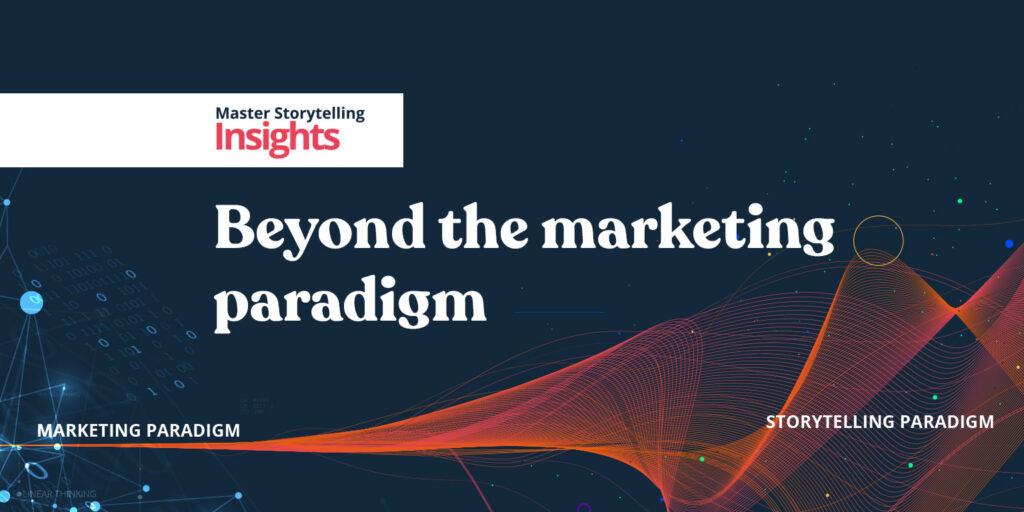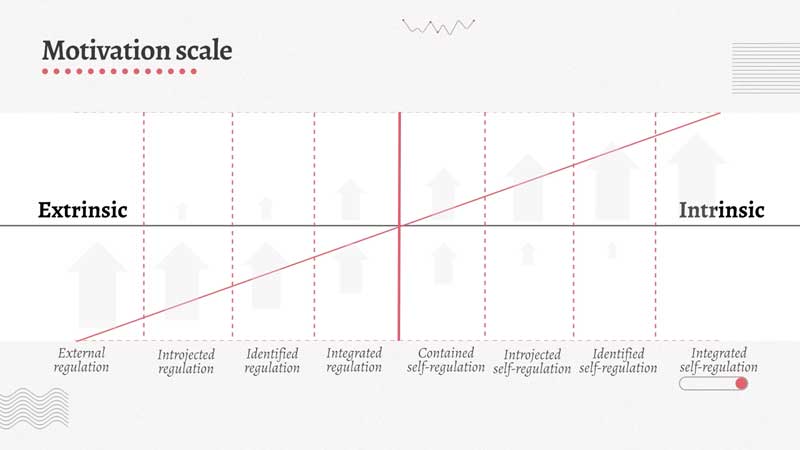The marketing paradigm is one of the most insidious and dangerous paradigms there is, creating so much harm not only to the natural world but also to the human family and the wellbeing of future generations. So why do we draw from the same paradigm that has caused so much harm to our world in work to engage and motivate audiences into positive change? And by doing so, are we inadvertently undermining our own causes?
‘What’s wrong with marketing?’ I hear you cry. We depend on marketing and marketing insights to drive audience engagement. If anything, we need to get better at it, not abandon it. But what if marketing logic is undermining our ability to create long-term behaviour change on the causes we care about?
The thought of transcending marketing theory and logic might sound like a pointless adventure, one that is hardly worth the effort. After all, there are many other priorities that we might want to turn our attention to rather than messing about with the fundamentals of our tried and tested approaches to audience engagement and motivation.
And why would we ever leave marketing theory and approaches behind? As we know, marketing works. We know it works and can prove its effectiveness through our fundraising and campaigning figures. It’s the reason why marketing theory and logic make up the backbone of all that we do in terms of audience engagement; it fuels our fundraising strategies, drives our campaigns and shapes how our organisations work and function as a whole.
So why would we ever consider changing it if it clearly works?
The answer to that question is simple. While marketing may work, it works at a cost, and given where we are in terms of our collective failure to bring about real and meaningful change on some of the biggest challenges we face today, that cost is too high for us to ignore any more.
To make sense of all of this, we first need to make the distinction between the marketing paradigm and marketing methodologies. Abandoning all forms of marketing techniques, resources and methodologies that drive audience engagement is an unrealistic expectation. These all unmistakably serve as useful tools. The shift here is in the way we think about how to engage our audiences, and whether we follow and accept the logic and values that marketing instils within us.
Marketing logic would dictate that If you want to motivate someone to buy your goods or services, you must create the need and show how your goods or services are the magical cure. Show the problem, and offer your product or service as the solution. This is basic marketing 101.
The promises are always the same, if you buy our product or service we can take your suffering away and help you live a better life. You will be happier with this new upgrade, fashion accessory, experience or product.
But in order to create the motivation for you to part with your hard-earned cash, there has to be a motivational trigger. Marketing works best when it creates anxiety or fear, and offers the product as a magic solution to taking away your anxiety. First, it creates anxiety, then promises to take it away. This is called inadequacy marketing, and it serves as one of the dominant approaches to almost all marketing approaches. It may work, but it is also a psychological pollutant.
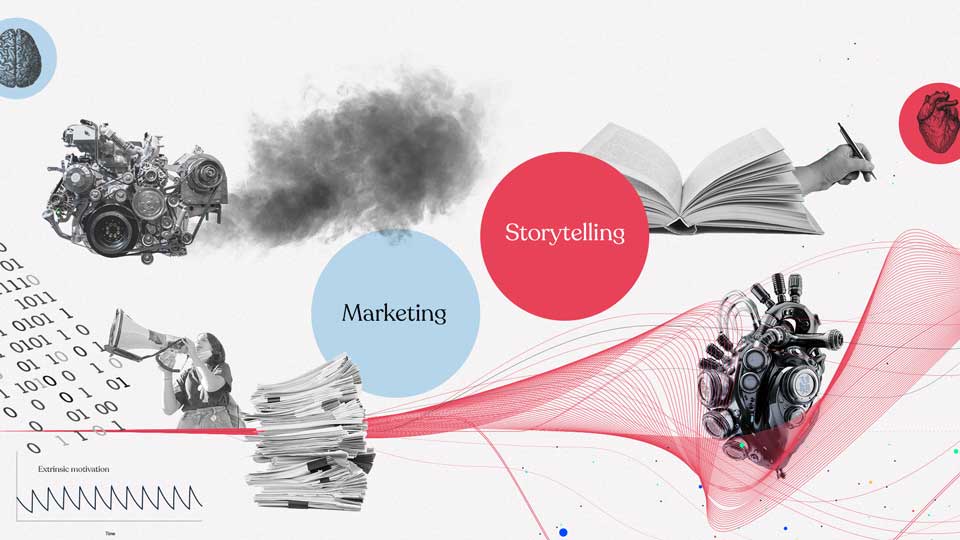
If we view this marketing strategy as a storyline, then this all too familiar narrative which drives the millions of marketing messages that make the background noise of our everyday lives, tells a rather depressing story about ourselves. By constantly playing to our lower values we are told again and again that we are not loveable (unless we are wearing the latest fashion item), we are not secure (unless you buy our insurance), we are not that great (we have lots of images of beautiful models to drive this message home) and we don’t have enough (something is missing in your life).
Given that marketers will boast that their marketing reach can cover up to 90% of the world’s population, with over $780 billion spent globally every year, it comes as no great surprise the huge influence marketing messages and the values they instil can play on our collective psyche. If they didn’t influence our values, it would be very unlikely that this highly sophisticated and omnipresent industry would attract the billions it does each year.
When we consider that the dominant technique in marketing is to play to our lower values of fear, greed and ego, then we should start to pay more attention to the fact that this inadequacy-driven marketing narrative has become the dominant story that we live by. It is our common story. Keeping us feeling inadequate is good for business and the economy, whereas emotional maturity and inner resilience are the enemies of capital growth.
If these marketing messages are to succeed, they must be carefully designed to gently whisper to our greatest fears, anxieties and insecurities without feeling like a form of manipulation. The more positive, engaging and attractive they are, while simultaneously playing to our deepest fears, ego and greed, the more power the marketing message has in terms of creating sales.
The danger is that we not only absorb these messages but also their values and logic, to the point where we embody these values and normalise the logic that they present to us. So much so, that we may find it hard to think in any other way when it comes to audience motivation. We wouldn’t hesitate to play to our audience’s fears, create anxiety, and play to their greed-based values when trying to engage audiences in the causes that we care about. We will happily create eco-anxiety and show how signing up for our latest climate campaign is the magic solution, or show images of poverty and how a regular payment can take away suffering.
Just like in marketing, we create anxiety to drive the behaviour. While it might work in the short term, playing to fears, creating anxiety, and over-promising how you can take away suffering, all create the psychological conditions in which long-term and positive behavioural change becomes almost impossible.
This is the paradigm trap. Where the values and beliefs of the marketing paradigm reshape how we think and imagine the world to be. We then use these values and beliefs to shape our campaigns and initiatives, further reinforcing the paradigm in the first place.
The nature of paradigms
Paradigms are best described as an all-encompassing pattern of thinking, where we collectively think in a certain way, and that thinking gets embedded into our collective consciousness. As paradigms shape how we think, they play a critical role in shaping how we perceive reality.
How we think, what we value and how we act is predominantly shaped by the paradigms we hold.
Kieran O'Brien - Director of Ministory Tweet
They also play a significant role in shaping our values, beliefs and our behaviours. How we think, what we value and how we act is predominantly shaped by the paradigms we hold, as all paradigms hold a values system that shapes, or rather distorts, how we relate to the world around us.
Remarkably, we rarely consider the role of paradigms in our work, nor make the connection between toxic paradigms and the work we are doing in terms of trying to create positive change in our world. Instead, we tend to focus much of our energy on external or explicit aspects of the problems we face, such as how we frame climate issues, what words and images we use, while overlooking dominant myths and the roles paradigms play in shaping our values, beliefs, and actions.
Fish story, taken from our training course, Master Storytelling – Climate Focus
The problem with paradigms is that they are extremely hard to spot. Just like the fish who doesn’t know what water is (see animation), we may not understand paradigms because we ‘swim’ around in them, failing to see what is everywhere, and therefore overlooking the powerful role they play in shaping and influencing our lives. The challenge is that we think through paradigms, while paradoxically we struggle to believe that they even exist!
Take for example the fundamental beliefs of the marketing paradigm.
- People are self-interested, we will only do something if we are rewarded in some way
- People are ego-centric and insecure, the way to drive the motivation to buy your product is to play to your lower values around greed, lust, fear and ego, as playing to higher values doesn’t seem to work as well.
- We will do anything to avoid suffering, that is why we will invest in a product or service that offers to take away suffering (whether it is by offering pleasure, security, convenience or helping us to overcome our ego insecurities)
- We are emotionally immature (fearful, anxious, insecure), and to sell our goods we play to our inner fears
When we make each of these fundamental beliefs explicit, we may find it incredulous to suggest that we subscribe to these beliefs. And yet, at the same time, we will promote our campaigns, fundraise, recruit volunteers, and promote our causes all in a way that re-affirms each one of these beliefs.
We would not blink an eye at showing how volunteering can be good for your CV, or you would get so much more in return. We would quite happily fundraise in a way that shows some sort of suffering, and how donating can take the suffering away. We would have no qualms in creating eco-anxiety, in order to drive engagement towards our latest eco-initiative or campaign. We will run raffles, knowing people will give if there is a chance of a reward for them. And so on.
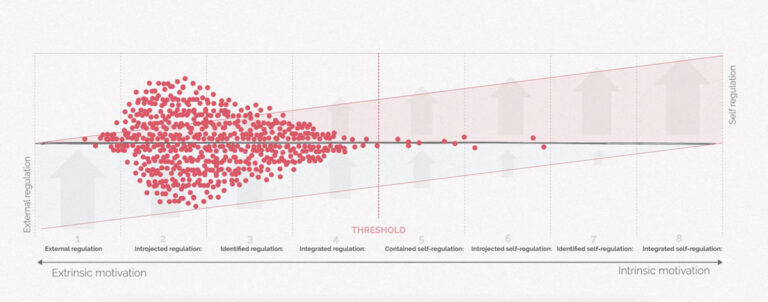
The natural bias of the marketing paradigm plays not only to our lower values, made up of fear, greed and ego but also to the lower stages on the motivation continuum.
When we use extrinsic motivational triggers to drive motivation, we tend only to create short-term results, undermining long-term behavioural change.
See New approaches to motivational theory
The nature of the marketing paradigm is towards profit, not towards behavioural change, it is designed to extract and manipulate, not to awaken us to a better version of ourselves.
In fact, the marketing paradigm thrives by doing the opposite, it thrives by creating the psychological conditions to keep audiences immature, emotionally fragile, highly anxious and insecure.
By creating these conditions we know that consumers will become more susceptible to the allure and promises made by marketing messages.
The nature of the marketing paradigm is towards profit, not towards behavioural change, it is designed to extract and manipulate, not to awaken us to a better version of ourselves.
Kieran O'Brien - Director of Ministory Tweet
Within the marketing paradigm, we can only become a better version of ourselves if we buy the goods or services that are on offer. Personal development, inner resilience, spiritual growth and inner fortitude are not favourable attributes in this dominant paradigm.
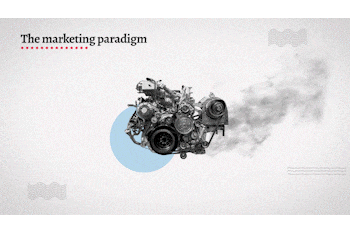
Marketing paradigm engine
If we imagine the marketing paradigm as a motivational engine. We use this engine in pretty much everything we do. We use it because it works. But, it works at a cost. Just like a fossil-fuelled engine, it is a pollutant, or rather, a psychological pollutant.
For this engine to work it needs to build a tension that will create the motivational drive. Without tension there will be no motivation. In classic marketing technique, that tension is built by creating anxiety, or some sense of inadequacy, followed by a sell of your product as the magical cure.
Or from a cause-driven perspective, show the problem and sell how signing up for your campaign or donating is the magical cure. The same basic marketing formula that drives mainstream marketing messages, is the same marketing formula we use to engage audiences with the causes we care about.
Every time we use this engine, it emits a psychological pollutant, and these psychological pollutants will remain despite our assurances that we can take them away if you sign up for the latest campaign or donate to our cause. The harder we push this engine the greater the pollution. The greater the pollution, the greater our collective anxiety. The greater the anxiety, the more we contribute to the psychological conditions which make change almost impossible.
The limits of positive messaging
Surely the answer here is simple? Instead of playing to people’s fears, ego and greed – which make up the core values of the marketing paradigm instead, we play to positive values such as love, solidarity and altruism. If playing to our lower values creates a psychological pollutant, then why not play to our higher values, and create positive messages?
It is here we enter a strange paradox. The more we lean toward higher values within the marketing paradigm, the weaker this engine becomes. Working with higher values is like pouring water into our fossil-fuelled engine, rather than increasing its torque, the engine just splutters and the motivational energy dissipates. In the marketing paradigm, higher values play an inhibitory role, while lower values play an enabling role.
For this engine to work it needs to create tension to drive motivation. Without tension, there is no motivation. When we play to people’s fears and we create anxiety, then provide the magic solution – classic marketing practice – we create a motivational tension in which to drive behaviour. But if we swap from fear and anxiety, and replace it with positive and aspirational content, it doesn’t quite work.
Positive messaging such as ‘Together we can make a difference!’, ‘Let’s change the world!’, can feel weak and rarely lead to long-term behavioural change. Positive messages tend to feel aspirational rather than transformational. Positive and aspirational content tend to feel weaker as they don’t create the necessary tension to drive motivation, as they no longer align with the motivational dynamics of the marketing paradigm engine.
If we use positive messages to try to create positive motivation, we don’t create the dynamics that create the tension. No tension, no motivation. The result is that our campaigns fall flat, audiences disengage and despite our best efforts we are unable to bring about the changes we seek.
So, what are we to do? If classic marketing techniques create psychological pollutants such as fear and anxiety, and positive and aspirational content doesn’t create the necessary motivation to drive real change, what is the way forward?
Our failure to answer this question and find an alternative motivation model means that we are forever trapped in the marketing paradigm. If creating fear and anxiety works, and aspirational messages don’t, then we will always lean towards the logic of the marketing paradigm as a default state. And in so doing, we will always struggle to awaken the necessary values needed to bring about the changes that we wish to see.
Escaping the paradigm trap
If we are trapped in the marketing paradigm, then surely escaping from this paradigm is our primary focus? The challenge is that escaping from a paradigm trap is not as simple as we may think. First of all, we need to understand that we are in a trap, and secondly we need to know how to spring the trap.
We can only transcend from old paradigms if the following two conditions are met: when the current paradigm starts to fall apart and can no longer serve our needs, and if there is a new paradigm to replace it that works better than the previous.
Just like a fossil-fuelled engine, we should view the marketing paradigm as a fully-functioning engine that gets us form A to B. But in so doing it creates psychological pollutants that will ultimately undermine the causes that we are working towards.
Whatever the new paradigm is, not only has it to work as well, if not better, than the marketing paradigm, but it also has to do so in a way that plays to our higher values and creates the psychological conditions for real and meaningful change to emerge.
This includdes the values needed to bring about positive long-term behavioural change, as well as positive political and social change.

We can only transcend from old paradigms if the following two conditions are met: when the current paradigm starts to fall apart and can no longer serve our needs, and if there is a new paradigm to replace it that works better than the previous.
Kieran O'Brien - Director of Ministory Tweet
If we take the climate movement as an example, if there is one thing that this highly active, well-resourced global movement has struggled with, is not the ability to highlight, educate and inform audiences of the seriousness of the climate emergency, it is in the task of motivation where it has struggled. This includes creating the necessary political will for change (social motivation). It would seem that it is not a lack of energy or enthusiasm that we are missing, but rather a lack of understanding of ourselves and what really motivates us.
It is not that we are failing to bring about real change, but rather that we are being failed by the very paradigm that we thought could get us there. It can’t. It is not in the nature of the marketing paradigm to awaken higher values in your audience, nor is it in the nature of the marketing paradigm to create the necessary political will that we desperately need to see on some of the most complex and interconnected challenges we face today.
Using the logic of the marketing paradigm to create positive change makes no real sense from a motivational perspective. It is akin to using a fossil-fuelled engine to power a carbon capture plant. It is logically inconsistent to use a psychological pollutant to drive positive change.
A new way is needed. We need a new engine. We call this the storytelling paradigm.
Using the logic of the marketing paradigm to create positive change makes no real sense. It is akin to using a fossil-fuelled engine to power a carbon capture plant. It is logically inconsistent. You can't use a psychological pollutant to drive positive change.
Kieran O'Brien - Director of Ministory Tweet
The storytelling paradigm
For millennia our great ancestors have gathered around fires to tell stories. These stories were not just for entertainment; they played a crucial role in shaping how our great ancestors related to the world around them. These would be sacred stories, that would have provided a canopy of meaning under which the tribe could cultivate and nurture the necessary values they needed to survive and flourish.
When we view indigenous cultures today, we can still see how the use of storytelling, mythology, rituals, and rites of passage all contribute to a meaning-making system out of which emerges the conditions for an impressive values base that keeps the community together, and to live in harmony with their natural surroundings. As a result, most indigenous communities today will feature very high pro-social and pro-environmental behaviours.
It is no coincidence that indigenous people, who only make up around 5% of the world’s population, are protecting 80% of the world’s remaining biodiversity. Indigenous communities know how to live in harmony with their surroundings and each other, and tend not to create highly complex legal structures to regulate behaviour, but rather they use stories, myths and customs. The qualities and values that they are rich in, are the qualities and values that we really struggle to engage.
So what can we learn from these story-rich communities, and can we rekindle some lost wisdom that we are clearly missing out on?
If we are to find real and meaningful solutions to the complex issues we currently face, we must be open to the idea that our current way of thinking may not be the most effective approach. We will do well to consider alternative paradigms, especially the ones that have proven to be so effective in driving impressive pro-social and pro-environmental behaviours, such as the paradigms that shape indigenous cultures.
This is why we need to turn to an ancient, and yet forever new, paradigm called the storytelling paradigm. This is a way of thinking that uses storytelling approaches to drive motivation. To work within this paradigm we need to know how to work with the unconscious mind, how to work with our higher values, and how to think differently, as inspired by wisdom traditions. Out of this paradigm, we can start to build a new motivational engine which naturally leans towards intrinsic values and intrinsic motivation.
Building this new motivational engine will take time to develop, as we will need to leave marketing logic behind and move towards storytelling logic. This will mean learning a whole new range of skillsets, including:
- Understand the true nature of stories and how they can create behaviour change
- Understand the nature of metanarratives, how they work, and how to engage them
- Understanding how paradigms work, and how to escape from the circular logic of the marketing paradigm
- Learn new approaches to motivational theory, and how to work with intrinsic motivation
- Develop our values-ception, our ability to see and work with the flow of values

Social change is achieved only by those who can challenge and disrupt dominant paradigms, or in other words, who can tell a new story.
Kieran O'Brien - Director of Ministory Tweet
- understand the hidden dynamics of the unconscious mind and how to work with the unconscious drivers that shape our behaviours and values, and how to apply these dynamics in storytelling
- Develop a way of thinking which is an intentional shift from rationality to relationality – which is the ability to work with the implicit nature and the metanarratives of storytelling
- Develop insights and skills to work with powerful intrinsic triggers in order to create the drive for our storytelling engine
Shifting from marketing to storytelling is not simply a case of learning how to tell stories, which most of us are already doing, but rather changing how we think, to transition from a manipulative and extractive mindset (marketing) to an empowering and liberating mindset (storytelling), to transition from face-to-face encounters (marketing) to shoulder-to-shoulder encounters (storytelling).
Making this shift requires specialist training, and developing a new skillset which is called Master Storytelling. This powerful approach to storytelling focuses more on the implicit nature of storytelling, how to create powerful metanarratives, how to drive behaviours using intrinsically motivated triggers, and how to break old paradigms that prevent real change from happening.
Our specialist training programme, highlighted below, is designed to help you develop key skills in this area of work, to help you become a Master Storyteller, and to help you transition from the traps of the marketing paradigm, and discover new insights into how you can create real and meaningful change on the causes you care about, by embracing the logic, values and insights of the storytelling paradigm.
Shifting from marketing to storytelling is not simply a case of telling stories, which most of us are already doing, but rather changing how we think, to transition from a manipulative and extractive mindset (marketing) to an empowering and liberating mindset (storytelling)
Kieran O'Brien - Director of Ministory Tweet
Insights
- The marketing paradigm represents a way of thinking, in which to motivate audiences you need to show the problem and sell the magic solution. This approach works, but it works at a cost. This motivational technique creates a psychological pollutant, as it works best when it creates anxiety or plays to our lower values around greed, fear or lust.
- Paradigms are often overlooked, even though they play a significant role in shaping how we interpret reality, as well as shaping our values and behaviour. We offer little attention to paradigms because we fail to spot them.
- We get caught in the paradigm trap because we fail to see the paradigms that we think through. As we think through paradigms, we mistakenly believe that the way we think is the only way to think.
- Positive messaging in the marketing paradigm holds very little motivational power, as aspirational messaging tends not to create a strong tension in which to drive motivation. Trying to shift from negative to positive messaging fails to solve the issue of creating the motivation for long-term behaviour change.
- There is a clear correlation between the marketing paradigm and extrinsic motivation, in which most marketing messages lean into the lower stages of the motivational continuum, utilising extrinsic motivation to drive sales.
- All paradigms have a values system, the marketing paradigm values system naturally leans towards the lower values of greed, fear, ego and lust.
- The marketing paradigm is the dominant paradigm for almost all audience engagement and motivation strategies, forming the backbone of fundraising initiatives, campaigning, volunteer recruitment, and so much more across the sector.
- The marketing paradigm’s ultimate aim is towards profit, not behaviour change. It thrives when it keeps its audience immature, needy, and passive. Within this paradigm, creating real and meaningful change on the issues we care about becomes almost impossible.
- The storytelling paradigm is not a new idea, as it incorporates insights on human behaviour taken from indigenous and ancient cultures, as well as wisdom traditions. These all had a different take on how to motivate, and how to create long-term behavioural change.
- Understanding how stories helped to shape human behaviour can help us to move away from face-to-face engagement (marketing) and move to shoulder-to-shoulder engagement (storytelling). By doing so we can start to reach out to cold and disengaged audiences who react negatively to face-to-face dynamics.
- Moving to the storytelling paradigm requires an entirely different approach, which requires training, new techniques, new toolkits and resources. Without these, we will struggle to make sense of the motivational triggers we need to create if we want to bring about real change.
Solutions
This article is proposing a necessary paradigm shift, from a marketing mindset to a storytelling mindset. To start this transitional journey we offer the following:
- Explore the nature of paradigms, how paradigms shape values and behaviours, and how to escape from paradigm traps. Our online, self-directed training programme Beyond the marketing paradigm covers all these in detail.
- Explore new approaches to motivational theory, and understand the links between the marketing paradigm and extrinsic motivation. Our article Motivational theory and audience engagement can help you get started.
- Start the journey towards becoming a Master Storyteller, where you can develop the skills, insights and techniques to work with metanarratives and the implicit nature of storytelling. Read our article Becoming a Master Storyteller to get started.
- Explore new approaches to motivation through storytelling methodologies. We recommend our full training course below which covers this in detail.
Our full online training course
New training programme.
Become a Master Storyteller with our specialist 13hrs+ online training course
Motivation theory
Explore a new approach to motivational theory and how to work with intrinsic motivational triggers
values theory
Insights into values theory and how to work with the flow of values and their relationship to each other
neuropsychology
Utilising insights on the different values systems of the two brain hemispheres and how to apply them
storytelling
Learn how to become a Master Storyteller, someone who can create powerful metanarratives
Storytelling training programmes.
These online, self-directed training courses are full of specialist insights, toolkits and methodologies that are designed to help you to create meaningful change in your work.
